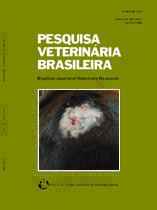 |
|
|
|
Year 2017 - Volume 37, Number 3
|

|
The use of Eucalyptus staigeriana nanoemulsion for control of sheep haemonchosis, 37(3):221-226
|
ABSTRACT.- Ribeiro W.L.C., Camurça-Vasconcelos A.L.F., Santos J.M.L., Macedo I.T.F., Ribeiro J.C., Oliveira E.F., Paula H.C.B. & Bevilaqua C.M.L. 2017. The use of Eucalyptus staigeriana nanoemulsion for control of sheep haemonchosis. Pesquisa Veterinária Brasileira 37(3):221-226. Programa de Pós-Graduação em Ciências Veterinárias, Faculdade de Veterinária, Universidade Estadual do Ceará, Avenida Dr. Silas Munguba 1700, Fortaleza, CE 60714-903, Brazil. E-mail: bevilaqua.uece@gmail.com
Sustainable control of gastrointestinal nematodes (GIN) in small ruminants has been based on the use of alternative methods, including targeted selective treatment, such as FAMACHA. Another GIN control alternative is the use of herbal medicines, although in many cases their use is based on empirical knowledge. Biopolymer nanoformulations has been investigated to maximize the essential oil effects against sheep gastrointestinal nematodes. The aim of the present study was to combine a Eucalyptus staigeriana essential oil nanoemulsion (EsNano) with FAMACHA as an alternative control for sheep haemonchosis. The study was performed over six months at a commercial sheep farm located in a semiarid region of Northeast Brazil. Initially, a fecal egg count reduction test (FECRT) in sheep with levamisole, ivermectin and oxfendazole in sheep was performed used to determine the most effective anthelmintic to use as the positive control. Levamisole has been selected because it showed efficacy superior to 95%. EsNano was obtained and then its physicochemical properties were characterized. The average (±SE) size of the particles in the nanoemulsion was 276.8 (±12.3) nm with bimodal distribution and polydispersity. Nine visits were performed, from April to September 2013, with an interval of 17 days. One hundred sixty-two male and female sheep were divided into three groups (n=54 each) and were treated when FAMACHA score was 3, 4, or 5: G-EsNano 250mg kg-1 EsNano; G-Lev 7.5mg kg-1 levamisole (positive control), and G-Neg was not treated (negative control). Feces from sheep were collected to quantify the number of eggs per gram of feces (epg) and to identify nematode genera. Sheep weight gain was monitored. The epg data for each group and the average sheep weight gains were analyzed by variance analysis and compared with the Tukey’s test (P<0.05). Significant difference between the number of animals treated with EsNano and levamisole was not observed in any visit (P>0.05). The epg variation was similar in the G-EsNano and G-Lev groups on visits (P>0.05), except the second and fifth evaluation in the epg groups were significantly different (P<0.05). Haemonchus spp. was the most prevalent nematode. There was no significant weight gain in any of the treated groups (P<0.05). The combination of phytotherapy and FAMACHA can be an alternative to minimize the use of synthetic anthelmintics to control resistant GIN populations of small ruminants. |
| |
|
|
| |
|
 |